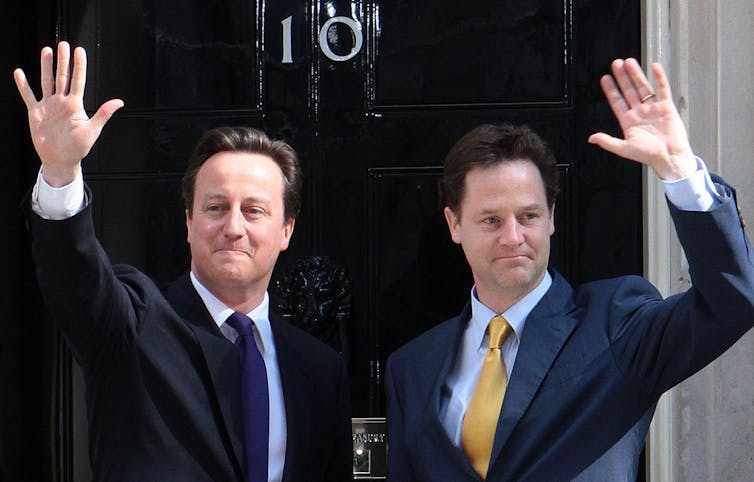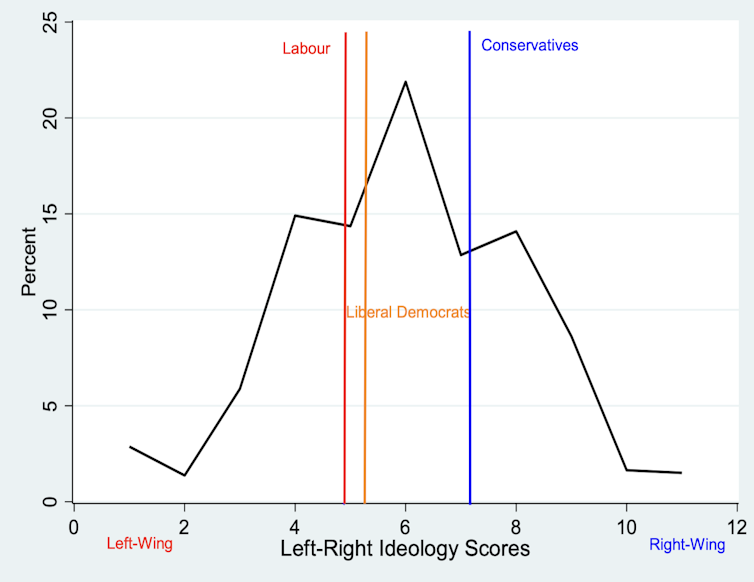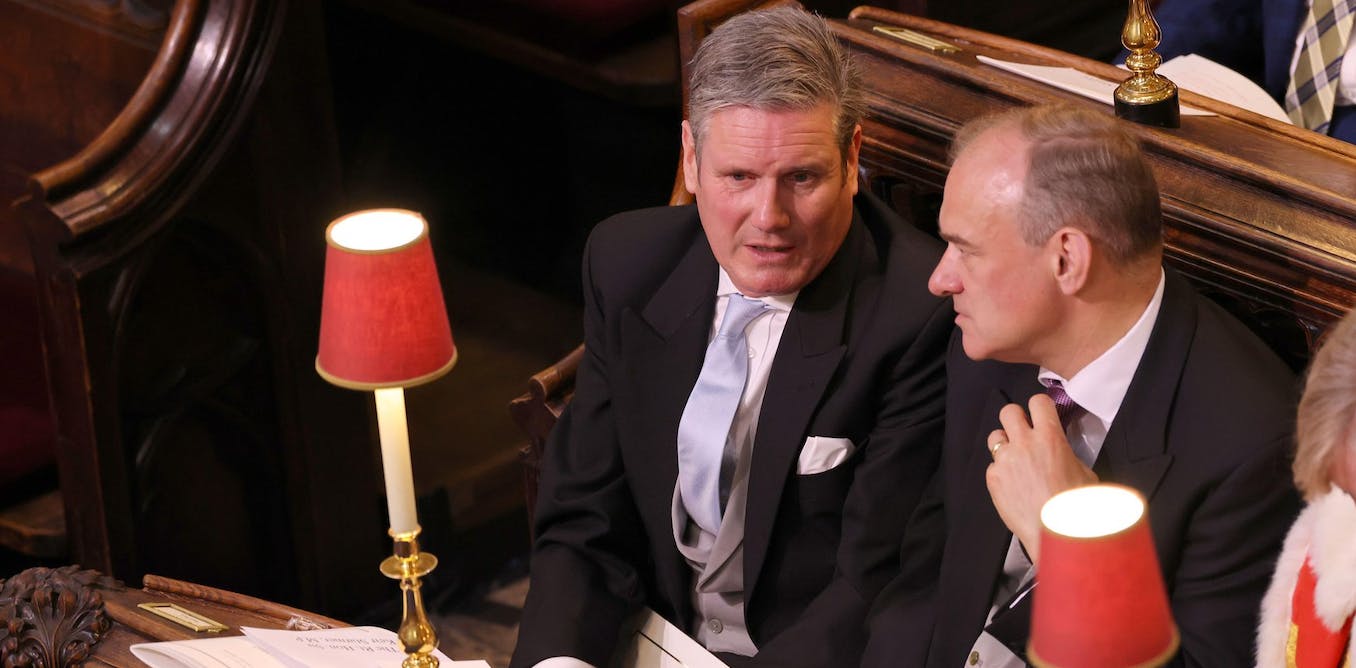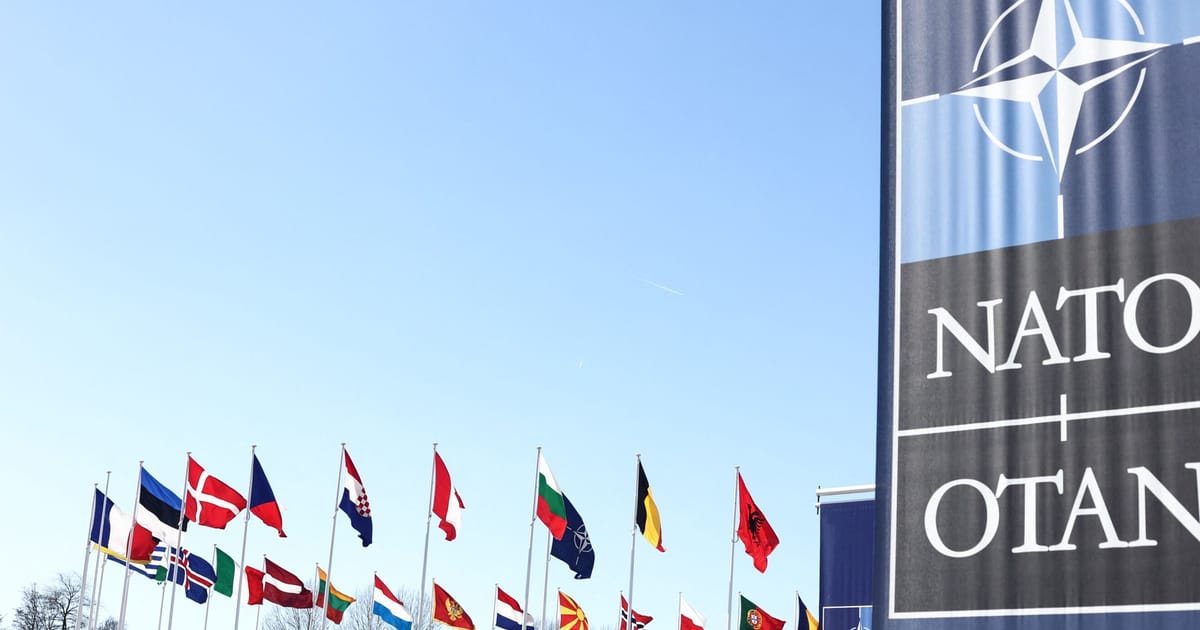Both Labour leader Keir Starmer and Liberal Democrat leader Ed Davey deny that there is any prospect of them forming a coalition government if the next election produces a hung parliament – despite that currently looking like a likely outcome.
Starmer’s reticence can be explained by the fact that if he talks about a coalition it is an admission that he does not expect to win, something his opponents will use against him in the campaign. Davey’s may in part be explained by the disastrous legacy of his party’s coalition with the Conservatives between 2010 and 2015.
Following the 2010 general election, the Conservatives won 307 House of Commons seats and the Liberal Democrats 57 seats. In the next election five years later, the Tories won 331 seats and the Liberal Democrats were reduced to just eight.
This traumatic loss of seats for the junior partner in that coalition has made Liberal Democrats very wary of entering another such arrangement in the future. But if the next election fails to produce a majority, Davey and Starmer are going to have to work something out. And the evidence suggests Davey at least has less to fear than he seems to think.
The cost of government
In an important 2005 paper, Danish political economist Martin Paldam examined what he termed the cost of ruling. He found that across 175 elections in 17 democracies, incumbent parties lost an average of just under 2% of their vote shares in successive elections over time.
Individual elections in different countries of course vary, but the rule applies generally. Further studies have supported this analysis and the consensus is now that the cost of ruling is just over 2% of the vote between elections.
There have been numerous attempts to explain why this happens and there is still uncertainty about the causes. One plausible explanation is the grievance-asymmetry theory, which suggests voters judge a party in government by its performance, but attach more weight to failures than to successes. If so, it would mean that governing parties tend to gradually lose support.
This idea is grounded in prospect theory from psychology, which views loss aversion as a product of human evolution over millennia. Our ancestors were much more concerned about threats to survival created by losses than about the benefits brought by gains.
Labour might look to this thinking to understand why it lost the 2010 election following the financial crisis and subsequent recession of 2008. It also helps to explain why the Conservatives are currently a long way behind in the opinion polls.
However, it does not explain why the Liberal Democrats took such a beating in the 2015 election when their partners in government, the Conservatives increased their vote to win an outright majority.
Seeking a suitable partner
There is, however, an alternative explanation here, namely the ideological distance between coalition partners. When a party forms a government with other parties that are ideologically distant, it will need to make bigger compromises.
This is particularly true if it is not the dominant party in the agreement. And U-turns on key promises can easily alienate supporters.
This is precisely what happened after the Liberal Democrats went into coalition with the Conservatives. Many of the party’s voters, particularly the younger ones, reacted badly when it reversed its commitment to abolish university tuition fees.
The rapid U-turn on this promise after the party joined the government, together with other concessions, had a marked negative impact on Liberal Democrat support.

Alamy
To test whether ideological differences with the Tories lie at the heart of what happened to the Liberal Democrats in 2015, the British Election Study’s 2010 post-election survey can help. Respondents were asked to locate themselves on an ideology scale from one (very left wing) to eleven (very right wing).
The chart below shows how respondents located themselves on this scale, with the largest group scoring the median value of six in the middle of the distribution.
Conservative, Labour and Liberal Democrat voter ideology:

P Whiteley, CC BY-ND
The three vertical lines show the average ideological locations of Conservatives, Labour and Liberal Democrat voters in that election. On average the Conservative voters scored 7.6, Labour voters 4.7 and Liberal Democrats 5.2 on the scale.
The distance between Liberal Democrats and Conservatives was 2.4 whereas the distance between Labour and the Liberal Democrat voters was 0.5. Put simply, Liberal Democrat voters were five times more distant in ideological terms from the Conservative than they were from Labour.
The conclusion is that the ideological proximity of their voters makes it a lot easier for the Liberal Democrats to form a coalition with Labour than with the Conservatives.
Their electoral prospects in the future are likely to rise and fall with those of Labour, rather than moving in the opposite direction, which is what happened in 2015. They may have their doubts about another coalition government, but the electoral consequences are likely to be very different from what happened in 2015.




